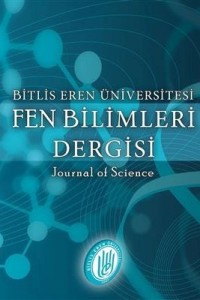Tekstil Endüstrisi Atıksularının Sonlu Filtrasyon Sistemi ile Nanofiltrasyon ve Ters Ozmoz Membranları Kullanılarak Filtrasyonu
Abstract
Mevcut çalışmada çeşitli
nanofiltrasyon (NF) ve ters ozmoz (TO) membranları ile tekstil endüstrisi
atıksularının filtrasyon performansları değerlendirilmiştir. Çalışmalar dead
end filtrasyon düzeneği ile farklı basınçlar altında yapılmıştır (10, 15, 20 ve
25 Bar). Test edilen nanofiltrasyon membranları NF90, NF270, NFTS40, NFXN45,
NFDK ve NFDL’dir. Ters ozmoz membranları ise ROX201, ROBW30FR ve ROACM5’tir.
Nanofiltrasyon membranları için basınç başına en yüksek geçirgenlik NF270
membranı ile elde edilmiş olup bu değer 5,95 L/(m2.h.Bar)’tır. Diğer
nanofiltrasyon membranlarına nazaran NF270 ile daha yüksek geçirgenlik değerine
ulaşılmasına rağmen, geçirgenlikteki birim zamanda en yüksek azalma da bu
membranda olmuştur. 15 bar basınç altında başlangıç geçirgenlik değeri olan 12,41
L/(m2.h.Bar) 1 saatlik test süresi sonunda, 4,41 L/(m2.h.Bar)’a
düşmüştür. Ters ozmoz membranlarında ise en yüksek geçirgenlik değeri ROACM5
membranı ile 2,96 L/(m2.h.Bar) olarak tespit edilmiştir. En yüksek
geçirgenlik düşüşü de yine ROACM5 membranında gözlemlenmiştir (hem 10 hem de 15
bar basınç için yaklaşık olarak 4,14 L/(m2.h.Bar)’dan 2,48 L/(m2.h.Bar)’a).
Nanofiltrasyon membranları için en yüksek renk, iletkenlik ve KOİ giderimi,
NF90 ile 4515 µS/cm iletkenlik; 518 Pt-Co renk ve 119 mg/L KOİ giriş koşulları
için sırasıyla >95%, >99% ve >97% olarak bulunmuştur. Daha yüksek
iletkenlik giderimi istendiğinde ise ters ozmoz membranlarının kullanılması
gerekmektedir. Test edilen ters ozmoz membranları için iletkenlik giderim
yüzdeleri aynı atıksuda ROBW30FR, ROX201 ve ROACM5 için sırasıyla >97%,
>98% ve >98%’dir.
Supporting Institution
TÜBİTAK
Project Number
113Y336
Thanks
Bu çalışma 113Y336 numaralı proje ile TÜBİTAK tarafından desteklenmiştir.
References
- 1. Marcucci M., Nosenzo G., Capannelli G., Ciabatti I., Corrieri D., Ciardelli G. 2001. Treatment and reuse of textile effluents based on new ultrafiltration and other membrane technologies, Desalination. 138; 75–82.
- 2. Amar N. B., Kechaou N., Palmeri J., Deratani A., Sghaier A. 2009. Comparison of tertiary treatment by nanofiltration and reverse osmosis for water reuse in denim textile industry, J. Hazard. Mater. 170; 111–117.
- 3. Yurtsever A., Sahinkaya E., Aktaş Ö., Uçar D., Çınar Ö., Wang Z. 2015. Performances of anaerobic and aerobic membrane bioreactors for the treatment of synthetic textile wastewater., Bioresour. Technol. 192; 564–73.
- 4. Asghar A., Raman A.A.A., Daud W.M.A.W. 2015. Advanced oxidation processes for in-situ production of hydrogen peroxide/hydroxyl radical for textile wastewater treatment: a review, J. Clean. Prod. 87; 826–838.
- 5. Körbahti B.K., Turan K.M. 2016. Electrochemical Decolorization of Reactive Violet 5 Textile Dye using Pt/Ir Electrodes, J. Turkish Chem. Soc. Sect. A Chem. 3; 229–246.
- 6. Sahinkaya E., Yurtsever A., Çınar Ö.2017. Treatment of textile industry wastewater using dynamic membrane bioreactor : Impact of intermittent aeration on process performance, Sep. Purif. Technol. 174; 445–454.
- 7. Ucar D., Armağan B. 2012. The removal of reactive black 5 from aqueous solutions by cotton seed shell, Water Environ. Res. 84; 323–327.
- 8. Uçar D. 2014. Adsorption of Remazol Black RL and Reactive Yellow 145 from Aqueous Solutions by Pine Needles, Iran. J. Sci. Technol. Trans. Civ. Eng. 38; 147–155.
- 9. Rodrigues C.S.D., Madeira L.M.,. Boaventura R.A.R. 2013. Treatment of textile dye wastewaters using ferrous sulphate in a chemical coagulation/flocculation process, Environ. Technol. 34; 719–729.
- 10. Van Der Bruggen B., Everaert K., Wilms D., Vandecasteele C. 2001. Application of nanofiltration for removal of pesticides, nitrate and hardness from ground water: Rejection properties and economic evaluation, J. Memb. Sci. 193; 239–248.
- 11. Cheng S., Oatley D.L., Williams P.M., Wright C.J. 2012. Characterisation and application of a novel positively charged nanofiltration membrane for the treatment of textile industry wastewaters, Water Res. 46; 33–42.
- 12. Lau W.-J., Ismail A.F.I. 2009. Polymeric nanofiltration membranes for textile dye wastewater treatment: Preparation, performance evaluation, transport modelling, and fouling control — a review, Desalination. 245; 321–348.
- 13. Erswell A., Brouckaert C.J., Buckley C.A. 1988. The reuse of reactive dye liquors using charged ultrafiltration membrane technology, Desalination. 70; 157–167.
- 14. Avlonitis S.A., Poulios I., Sotiriou D., Pappas M., Moutesidis K. 2008. Simulated cotton dye effluents treatment and reuse by nanofiltration, Desalination. 221; 259–267.
- 15. Zahrim A.Y., Tizaoui C., Hilal N. 2011. Coagulation with polymers for nanofiltration pre-treatment of highly concentrated dyes: A review, Desalination. 266; 1–16.
- 16. APHA. 2005. Standart Methods for the Examination of Water and Wastewater., 21st ed., Washington DC. USA,.
- 17. Mukherjee D., Kulkarni A., Gill, W.N. 1996. Chemical treatment for improved performance of reverse osmosis membranes, Desalination. 104; 239–249.
- 18. Balannec B., Vourch M., Rabiller-Baudry M., Chaufer B. 2005. Comparative study of different nanofiltration and reverse osmosis membranes for dairy effluent treatment by dead-end filtration, Sep. Purif. Technol. 42; 195–200.
Details
| Primary Language | Turkish |
|---|---|
| Subjects | Engineering |
| Journal Section | Research Article |
| Authors | |
| Project Number | 113Y336 |
| Publication Date | June 15, 2020 |
| Submission Date | July 28, 2019 |
| Acceptance Date | December 6, 2019 |
| Published in Issue | Year 2020 Volume: 9 Issue: 2 |

